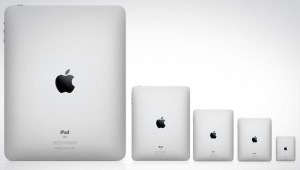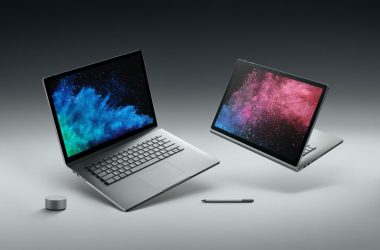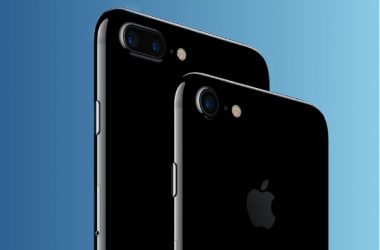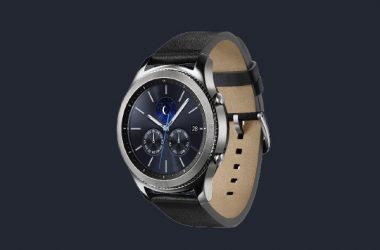 It’s been two and a half years since Steve Jobs unveiled Apple’s idea of what a tablet should be — the now iconic iPad. Since then, more than 100 million iPads have been sold. They’re seemingly everywhere: Doctors use them to organise patient records; football teams use them as playbook replacements; musicians use them to create music, and artists, art; companies are adopting them by the thousands for a variety of purposes and school students use them for study.
It’s been two and a half years since Steve Jobs unveiled Apple’s idea of what a tablet should be — the now iconic iPad. Since then, more than 100 million iPads have been sold. They’re seemingly everywhere: Doctors use them to organise patient records; football teams use them as playbook replacements; musicians use them to create music, and artists, art; companies are adopting them by the thousands for a variety of purposes and school students use them for study.
Unwilling to cede the 7-in. tablet market to anyone, Apple on Oct. 23 introduced the iPad Mini (along with a number of other important updates, including a fourth-generation iPad with a faster processor and a 13-in. MacBook Pro with a Retina display). Pre-orders for the iPad Mini started two days later and the first ones arrived Friday — including the one I bought for myself (a black 32GB Wi-Fi-only model). Prices start at $329 for the 16GB Wi-Fi-only model and climb past $600 if you want more storage and cellular wireless capabilities, Including LTE where available.
The iPad Mini is pretty much a shrunken iPad 2. At 7.87-in. high, 5.3-in. wide, it’s about two-thirds the size of the full-size, 9.7-in. iPad and weighs just 0.68 of a pound. And it’s just over a quarter-inch thick.
Therein lies its main appeal: You get pretty much the full iPad experience in a smaller, thinner and lighter package. After extended time using the Mini, my wrists never felt the fatigue inherent in using the heavier 9.7-in. iPads, which weigh just under 1.5 pounds.
Technical details
The Mini’s LED-lit 7.9-in. screen offers the same resolution as non-Retina iPads: 1024 X 768 pixels (though those pixels are packed closer together in the smaller iPad, making the screen a little sharper than on the iPad 2). The screen is encased in a sleek, minimalist black/slate or white/silver aluminum-and-glass housing. If you’ve seen the new iPhone 5, you have an idea of what the iPad Mini case looks like.
The Mini uses a dual-core Apple-designed A5 processor, a battery designed for up to 10 hours of use on the Wi-Fi model or nine hours with cellular use, and front and back cameras for photos and video. The front-facing 1.2 megapixel camera can shoot 720p HD video for high quality video chats, while the rear-facing 5MP camera can take 1080p HD video.
Like other iPads, the on/off switch is located on top toward the right, while on the upper right side is a user-configurable mute/rotate-lock switch, as well as volume up and down keys. The round home button remains the single physical part on the iPad’s front face.
All models feature 802.11a/b/g/n Wi-Fi (with 802.11n in 2.4GHz and 5GHz frequencies), as well as Bluetooth 4.0; the new, thinner, reversible Lightning connector; a 3.5mm stereo headphone jack, built-in stereo speakers, a microphone, a digital compass, three-axis gyro, an accelerometer, an ambient light sensor, and support for Apple’s digital assistant, Siri.
Look and feel
After using a variety of 7-in. tablets in recent months, I can safely say the iPad Mini is unmatched in build quality by any of its competitors. But the best thing is that this model has remedied the biggest problem with the iPad line-up: weight. I never got tired of holding the Mini the way I have when using a regular iPad. Like the iPhone 5, the iPad Mini feels like a sci-fi movie prop; it’s hard to imagine it will actually function until you turn it on.
A full-size iPad (rear) with the new iPad Mini in front. (Image: Michael deAgonia).
When I pulled the Mini out of the box and pressed the power button, the battery was almost fully charged, at 98%. I was able to set up the iPad using an iCloud restore, which automatically brought over all of my information, including user data such as app and system settings, text messages, calendars, email and contacts, camera roll pictures, photo streams, and apps and assorted media from iTunes.
I was immediately impressed by the design: the anodised aluminum and thinner/smaller/lighter package feels great in the hand. I wasn’t the only one to notice. Coworkers flocked to see the device, and even the most hardened IT guys admitted a soft spot for Jonny Ive’s design.
I really can’t emphasise how great the iPad Mini feels in hand. It’s very light while still feeling solid, not at all flimsy for a device so thin. The front borders surrounding the screen are so thin, placing a thumb on the screen will be unavoidable for many users; but that’s okay. Apple engineers have updated iOS to compensate, and in my testing, I never accidentally shifted the screen contents due to thumb contact.
I found battery life to be excellent, running all day and into much of the night while downloading more than 20GB of data via WiFi in an afternoon. The iPad Mini was still going strong into the next afternoon before I decided to recharge it when battery indicator dropped to 10%.
Good product design is one thing, but these days, that alone isn’t enough to guarantee success. A robust app and content ecosystem, reliability, interoperability with current devices and longevity are what count. The good news is that the iPad slips right into Apple’s digital ecosystem. With more than 700,000 iPhone and iPad apps (275,000 specifically designed for the iPad), the largest collection of music available in one place, 1.5 million iBooks, and iCloud for data syncing and backups, all of Apple’s digital wares and services work just as well on the iPad Mini as on any other Apple device. So if you’re already invested in Apple’s ecosystem, this device won’t let you down.
The only caveat is the new Lightning dock connector, which is not backwards compatible with the old 30-pin dock connectors Apple and third-party accessory makers have been using for the past decade. Apple sells adapters, but be sure to check compatibility before purchasing.
The screen
When it comes to the iPad Mini’s screen, whether you’re impressed by it or not depends on your own experience. The office visitors who arrived just to gawk at the new tablet had one of two reactions: the screen was either gorgeous or lackluster. Accounting for the difference of opinion: whether they’d already seen one of Apple’s Retina-class displays. Those who were used to a Retina display on an iPhone, iPad or the MacBook Pro released last summer quickly noticed the lack of it here. Those who haven’t used an Apple product with such densely packed pixels found the iPad Mini’s display impressive.
The screen is clearly not a Retina display; it’s especially noticeable to me with on-screen fonts. Of course, it doesn’t help that I’m surrounded by Retina products every day, including my own iPhone 5 and a larger iPad, plus the 13-in. MacBook Pro I’m using and will review soon.
The iPad Mini is essentially a scaled down iPad 2. (Image: Michael deAgonia).
The pixel density is still greater than on the iPad 2 (163 pixels per inch, about half the pixel density of a Retina display), and color reproduction, brightness and viewing angles are all high-quality on the iPad Mini, thanks to the use of IPS technology. This weekend, I found myself reaching for this device more often than my iPhone 5 or my Retina iPad, so the pixel density can’t really be bothering me too much.
Although the screen on this device is, obviously, physically smaller than on the larger iPads, the 1024 X 768 pixel count means iOS 6 works without any modifications. There are smaller touch points in the software, though, which you’ll notice if you’re accustomed to the larger iPads. But the difference is not a hindrance in usability. And two-handed typing feels pretty natural on this size device, especially when the keyboard is split virtually.
As with other iPads, the screen is a fingerprint magnet. But it cleans up with a simple wipe with a soft cloth.
More about trade-offs
I haven’t decided whether I enjoy the size or the weight of Apple’s new iPad more, but I’m leaning towards weight. After spending the last few days with the separate iPad models, I’ve noticed that my reactions to the iPad Mini and the larger iPad with Retina display are completely opposite. When I pick up the iPad Mini I think: wow, the size and weight is fantastic and ideal. Then, once it’s turned on, it takes a few seconds to get used to the lower-resolution display. With the full-size iPad, my first reaction is always that the device is heavy, especially in comparison to the Mini. But once it’s turned on, I’m impressed by the image quality. It’s all about trade-offs. The difference between models will no doubt polarise users, but at least the support for multiple screen sizes within the Apple ecosystems are there.
If I were to go with a Goldilocks comparison here, cliche as it is, the iPad Mini is clearly designed for those who think the regular iPad is too big, and the iPhone/iPod touch too small.
Final thoughts
So, where does the iPad Mini fit in? Is it a kiddie iPad — the one adults hand off to kids? Is it the mass education iPad, displacing its larger sibling as the go-to tablet for school? Or is this a better reading device, a shot fired at the Kindle? Most importantly, will the lower cost and smaller size offset the loss of a Retina display and a more powerful processor in the larger iPad?
The answer is yes to all of those questions. The iPad Mini can be all of these things, and more, with enough software — and, eventually, the accessories — to allow it to be whatever you need. The iPad Mini is still a full-fledged iPad, albeit in a smaller package. The main compromise here is about screen quality versus size and weight, not about the quality of the user experience.
I think the most important aspect of the Mini isn’t the resolution or even the screen size — it’s still not entirely pocket-friendly. It’s the weight. You can comfortably hold it in one hand for extended periods of time without strain, a huge benefit over the larger Retina-display iPad.
Apple is late coming to the mid-size tablet market, but it’s so far ahead of its rivals when it comes to tablets that it should be able to carve out a huge chunk of market share in short order. Supplies are already tight.
The new fourth-generation iPad may be faster, and it does have the gorgeous higher-resolution Retina display, but it’s still heavy. If size and weight stopped you from an iPad purchase before, the Mini is tailor made for you.





